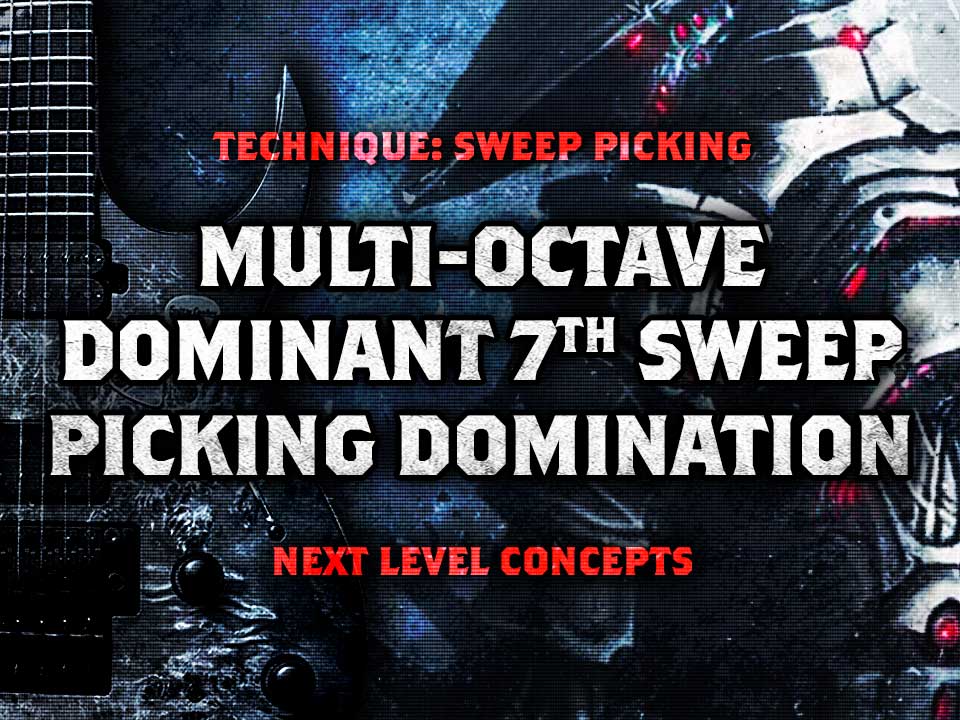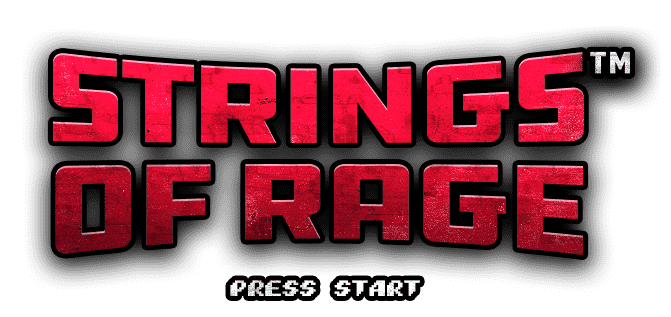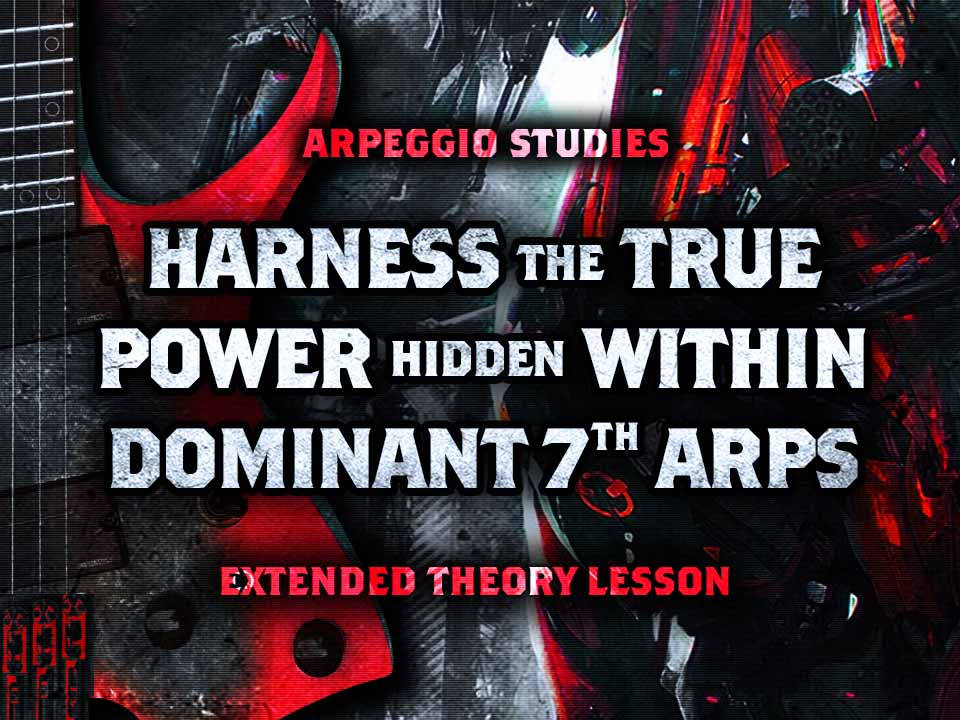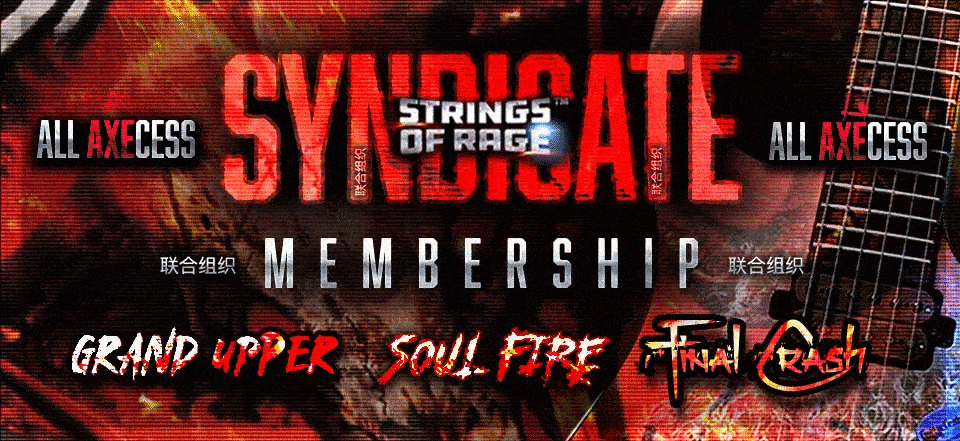Dominant 7th Arpeggios have many versatile hidden secrets that most players aren’t aware of. In this lesson we’re going to learn how to harness the true powers hidden within the dominant 7th arpeggio.
Most players who are familiar with music theory will associate the dominant 7th arpeggio with the mixolydian mode (mode number five) of the major scale. While this is true, it is just one of many ways in which we can derive this arpeggio. In this lesson we’re going to look at other scales and modes that contain this arpeggio as well as some modern triad pairings to create some super cool altered dominant sounds to add to your arsenal. Let’s Go!
Dominant 7th Arpeggio Basic Theory
Dom 7th Interval Structure : R – 3 – 5 – b7
The most standard way to use the dominant chord or arpeggio is to set up a resolution within a musical progression. This is because the dominant 7th arpeggio has a desire to resolve to the I chord in both major and minor keys.
For example in the key of E major, the V chord would be B7 (B Dominant 7th) which resolves perfectly to the I chord which is of course E Major. Equally in a minor key the same concept is true. In the example of the key of A minor, the V chord would be actually be Eminor. However it is common practice to substitute this chord for a dominant chord of the same root since it has a stronger pull to the I chord. E7 resolves perfectly to the I chord of A minor.
Regardless of scale extensions, as a minimum any scale or chord that has a Root, Major 3rd and a Minor 7th will be considered some kind of dominant tonality.
Dominant 7th Arpeggio Derived from Mixolydian
Mixolydian Mode Interval Structure : R – 2 – 3 – 4 – 5 – 6 – b7
Most commonly you would derive a dominant 7th chord or arpeggio from the Mixolydian mode. The Mixolydian mode is the corresponding mode of the major scale for the dominant chord in a given major or minor key and includes a b7 scale degree. This is the note that is different compared to the major scale. The b7 is the note that will really help define the dominant sound.
Dominant 7th Arpeggio Derived from Dominant Pentatonic Scale
Dominant Pentatonic Interval Structure : R – 3 – 4 – 5 – b7
You may have also noticed within the Mixolydian mode you also can derive the Dominant Pentatonic Scale. This scale is very similar to the standard minor pentatonic that you will likely already know. However this has a major 3rd interval and not a minor 3rd interval.
The dominant pentatonic in itself only has 1 extra note than the dominant 7th arpeggio. Just like the Mixolydian mode the dominant 7th arpeggio is right there in the scale. You can derive a dominant 7th arpeggio from the dominant pentatonic scale simply by eliminating the 4th scale degree.
Dominant 7th Arpeggio Derived from The Lydian Dominant Mode
Lydian Dominant Interval Structure : R – 2 – 3 – #4 – 5 – 6 – b7
This is where things start to become very interesting, this is also where the dominant 7th arpeggio starts to take on a different type of sound altogether. The dominant 7th arpeggio can also be derived from two of the modes of the Melodic Minor Scale. The Lydian Dominant mode is mode number four of the Melodic Minor scale.
This now means you can start to merge the dominant 7 sounds with some of the extensions of the Melodic Minor modes to introduce some altered colours into your playing. On top of this it also means that you can play dominant 7ths over altered chords that can be derived from these modes and start to think more outside the box.
Dominant 7th Arpeggio Derived from The Mixolydian b6 Mode
Mixolydian b6 Interval Structure : R – 2 – 3 – 4 – 5 – b6 – b7
The second possibility to derive a dominant arpeggio within melodic minor comes from the Mixolydian b6 mode. The clue is in the name with this one. It’s just like the standard Mixolydian mode but with a b6 alteration. The unique thing here is that you have two dominant chords a whole step apart between these two melodic minor modes. This alone could open up a whole host of original ideas.
Again, experiment with using the dominant 7th arpeggios over the altered dominant chords found within the melodic minor modes.
Dominant 7th Arpeggio Derived from The Phrygian Dominant Mode
Phrygian Dominant Interval Structure : R – b2 – 3 – 4 – 5 – b6 – b7
The Phrygian Dominant mode is mode number 5 of the Harmonic Minor Scale and is one of our absolute favourites for good reason. Phrygian Dominant is every prog players favourite mode, even this mode alone is full of it’s own wondrous secrets.
Using the dominant arpeggio that can be found within this mode perfectly provides the opportunity to dip in and out of the exotic sounds of Phrygian Dominant. Mix up your arpeggio playing with the b9 and b6 of this scale for maximum effect.
Advanced Ideas for Application: Creating the Sound Using Triad Pairs
The concept of triad pairs is a creative way of combining two triads from a scale to form and ‘create’ the sound and tonality of the scale or mode. The idea here is to use two triads with completely different notes to one another. This way when you combine ideas together you’ve either got 6 or all 7 notes of the scale.
Triad Pairs: Example Using E Lydian
Target Tonality: Maj7#11
For example lets look at the E Lydian mode. The lydian sound is really defined by the presence of the #4 in the mode. With the triad pairs we’ll be creating or forming a Major7#11 sound. In E lydian, you can build an E major triad from the root note and you can also build an F# major triad from the 2nd which is F#.
Here’s where it comes together, remember we’re not treating the F# as the root note of the F# triad – we’re thinking E lydian. So the E major triad has a Root, Major Third and Fifth from the E lydian mode. If we now look at the F# major triad with E as our root note (or playing over the E triad) you should hopefully notice that this triad contains the major 2nd, sharp 4th and major 6th of E lydian. With these two combined we have 6 out of the 7 notes of the E Lydian mode thus forming the desired lydian sound.
In this Lydian example we could extend the E major triad to add in the major 7th. This would give us E major 7th and therefore yield the complete 7 note lydian mode & Major7#11 chord tonality.
Triad Pairs: Example Using B Mixolydian b6
Target Tonality: Dominant 9#5 or 11#5
Now let’s look at an example of extended triad pairs using our B dominant 7th arpeggio in the context of Mixolydian b6. B Mixolydian b6 should yield an altered dominant sound such as a B9#5 or even a B11#5 if we wanted the 4th in there as well.
If we take the B7 from our B Mixolydian b6 mode we can then ‘fill in the blanks’ to see what triad we are left with in order to combine these sounds.
In this example we have a C# diminished triad left from our Mixolydian b6 mode. This means we can write riffs using either B7 or C# diminished arpeggios and play our lead lines on top using both of these arpeggios to form the altered dominant tonality.
Composition: Other Instruments
Think about supporting the triad pair concept with bass guitar and keyboards. For example your bass guitar could play notes from the B7 while the rhythm guitars are playing the C# Dim. You could also have a keyboard string patch playing a static B7 chord to support the lead guitar further. There is no limits to how you could approach this. The goal here is to create the sound of the mode by combining notes from triad pairings.
Dominant 7th Arpeggio Inversions & Other Possibilities
For complete reference here are some ways to play the inversions of this arpeggio. These work out quite nicely for sweep picking but don’t feel you have to play them this way. If your interval knowledge is good we would encourage you to explore and map out the inversions in ways that makes sense for your fingers. Do experiment!
String Skipping & Tapping
As well as sweep picking we’ve also demonstrated a single root position for string skipping and tapping. You should extend these ideas further by experimenting with additional extensions and learning the other inversions as well.
B Dominant 7th Across the Entire Neck
Here is B7 across the neck. We’ve demonstrated it between open and fret 12 – beyond that it’ll repeat in octaves. If you know your notes and intervals, you should be able to play this arpeggio in any way you desire. The goal should be to see the intervals and not become prisoner to ‘shapes’.
Expander! Even More Killer Dominant Ideas…
If you love the dominant sounds as much as us, check out this lesson we did a while back. This one is super cool and contains some ideas showing how you can sweep though dominant arps in a unique way. This one also has some video examples! Bare with us, we’ve got lots of killer video lessons coming!

Cheers!
Video Lesson & Dominant Arpeggio Sick Licks Book Coming Soon for Patrons!
Thanks for checking out our lesson! We hope it’s helped to unlock some new possibilities with dominant chords and arpeggios that you may not have thought of otherwise.
Strings of Rage™ Patrons
All Patrons get early access to our content, tab books, backing tracks, guitar pro tabs and more. All memberships are hugely appreciated and are helping us to deliver an awesome online experience and lesson content.










No Comment